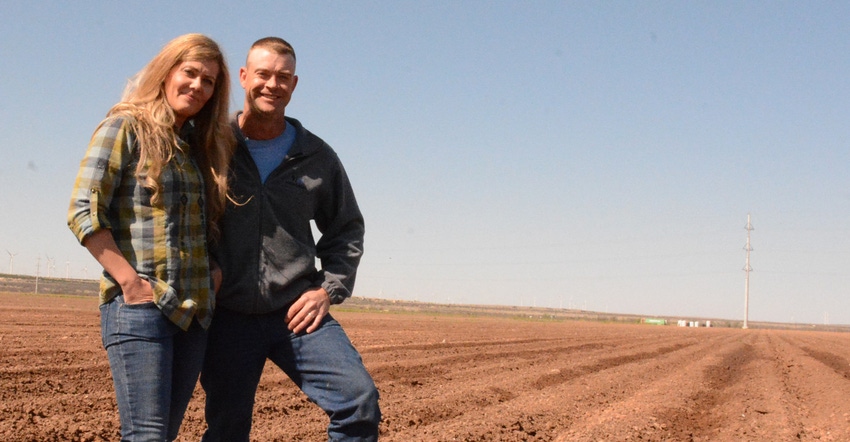
Vance and Mandie Smith have taken their irrigation underground to increase farm efficiency at the ground level, an investment that has not only yielded well but increased the sustainability of their farm.
“We farm in the desert. Water is a limiting factor,” says Vance Smith, a fifth-generation farmer. “Eighteen years ago, we shed the poly pipe and row-water irrigated pipe and the sprinklers and installed our first drip in 2001 and finished this farm in 2011.”
The Smith’s produce Pima and upland cotton near Big Spring, Texas. About 60 percent of their land is dryland with the remaining 40 percent irrigated by subsurface drip.
See, Farm wife: growing cotton is personal, not just a commodity
Converting to drip irrigation has made a “massive difference” in their operation, Vance says. “Where we had center pivots, we were only watering 75 percent of the acres, because we were in a circle. We were limited by space and shape.”
But with subsurface drip, he says he can farm every acre.
“We're in an irregularly shaped area. We have the Concho River running through the middle, it winds and curves. We can get corners and little pieces and make everything fit, whereas before we were wasting a lot of ground.”
The underground system has also halted evaporation. “We have very high temperatures in the summertime. We have a lot of evaporation. Typical loss in this area from a sprinkler is 30 percent so, when we made that change, we lost everything to do with evaporation because we're watering from underneath. We're getting 100 percent of our water.”
And with drip, Vance says they need less water to irrigate more acres. “Our yields have increased by 25 to 30 percent.”
See photo gallery, Wrangler uses locally-sourced sustainable cotton in new collection
Though drip is an expensive investment, about $1,200 to $1,800 per acre, Vance says the returns far outweigh the cost. “The drip has by far paid for itself in two and a half to three years just in water savings and increase in yields. It's been a massive blessing to us.”
Vance also credits his subsurface drip for increased efficiency in fertilizer application. “We’re able to put most of our fertilizer through the drip system. The water and fertilizer go right to the root zone, so it's not being wasted and spread over a large area where it's not needed. It's pinpoint accurate to the roots on the plant.”
And because the Smiths aren’t having to make extra passes through the fields with tractors and side-dress machines, Vance says they are also saving fuel, wear and tear on equipment and labor. “All we have to do is inject it right through the water system.”
CROP ROTATION
Other sustainable tools the Smiths utilize are cover crops and crop rotation. “On irrigated ground, about 25 percent is corn, approximately 50 percent is ELS or Pima cotton and then the other 25 percent upland cotton. We're on a four-year rotation.”
The Pima cotton is conventional. “There's no GMOs and we’re going back to using some conventional tillage but using a lot of hand labor on things.”
“Like your wife,” says Mandie, laughing, and adding that hoeing keeps her fit and out of trouble.
“We're able to do a good job with it mechanically and with the rotation,” says Vance. “The corn's are GMOs, but they use different chemicals than the cotton. So, we'll run the corn, and give it a unique mode of action, and then go back to conventional and then come back with an upland cotton and use those specific chemicals, “so, we don't have a weed resistance issue here because everything is constantly changing.”
While Vance admits he’s not a big dicamba fan, he says most of his upland cotton varieties are Roundup Ready.
For a cover, Vance leaves behind the corn stubble but pulls the cotton stalks. “We have to. We grow too big of a cotton stalk. If we don’t pull those, we lose tires like crazy.”
About the Author(s)
You May Also Like






